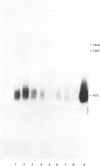Abstract
The role of metallothionein (MT) was assessed in the copper-loading disease prevalent in Bedlington terriers. Fractionation of tissue supernatants over Sephadex G-75 showed that most of the additional cytosolic copper present in liver tissue of these dogs was bound to MT, and that substantially more MT-bound copper could be solubilized by detergent plus mercaptoethanol. Zinc contents were only slightly raised, although most of the extra zinc was associated with a 4000-Mr ligand. Ion-exchange chromatography revealed two isoproteins, MT1 and MT2, in all the dog liver samples examined. In Bedlington terrier liver, copper associated with both isoproteins was increased, although the increase for MT2 was greater than for MT1. The content of MT protein was also raised, although cell-free translations and RNA blots of total liver RNA showed that this increase was not associated with a rise in MT mRNA. The significance of these results to the mechanism of copper accumulation in the Bedlington terrier disorder is discussed.
Full text
PDF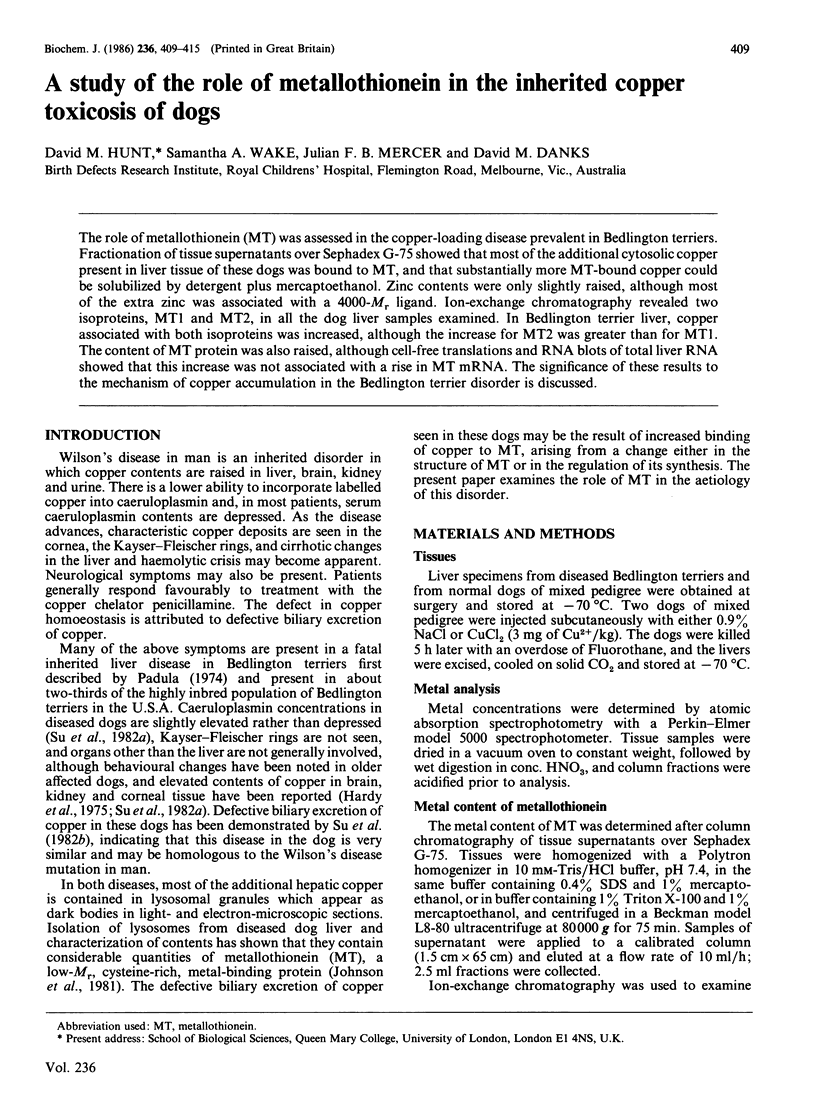
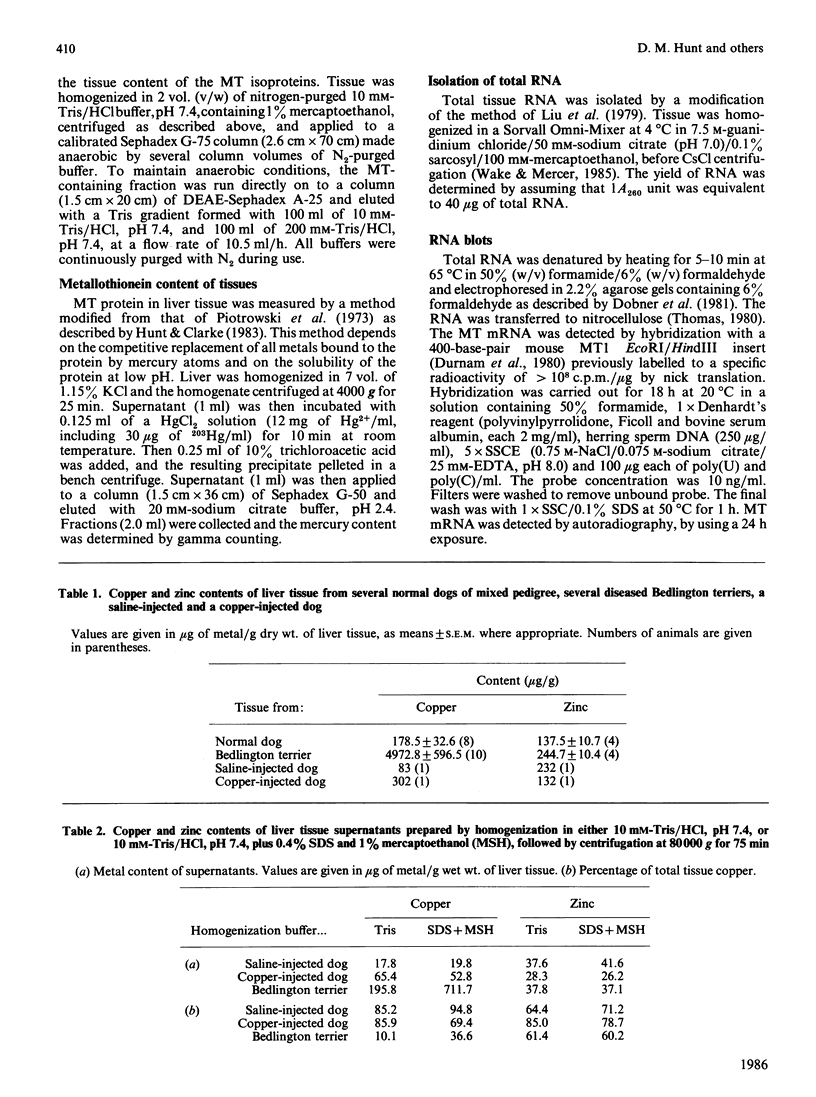
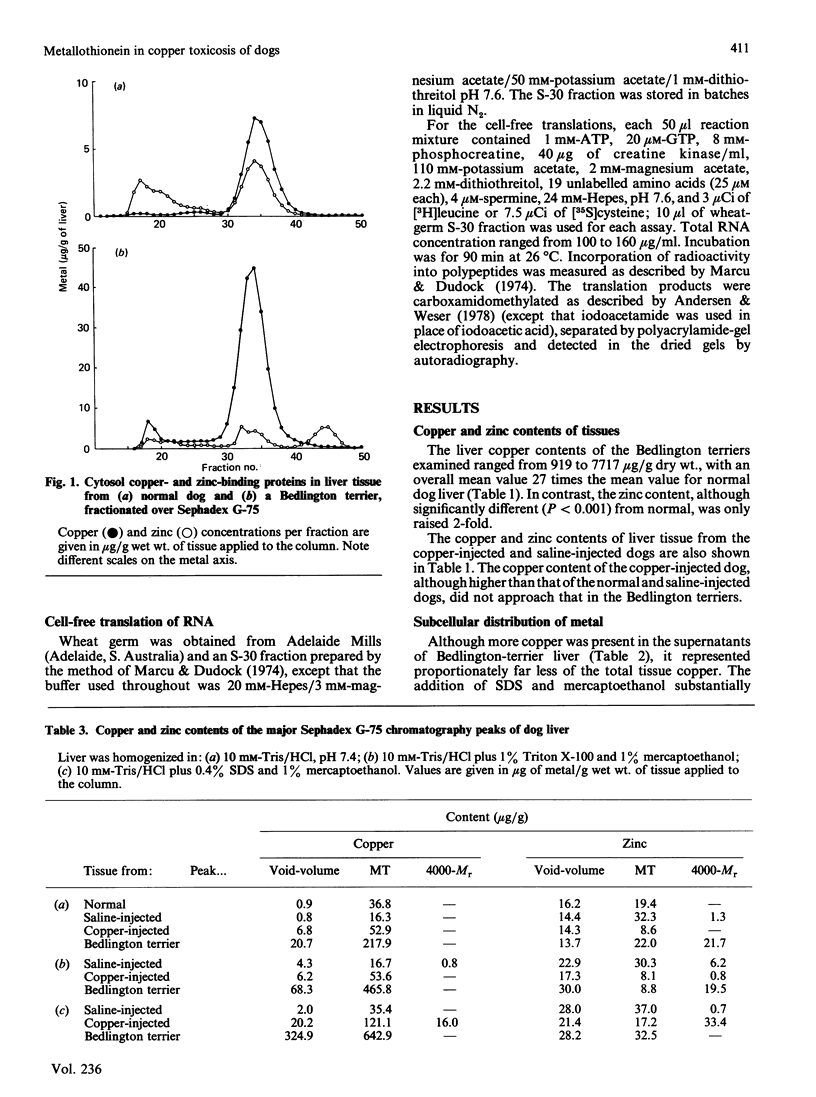
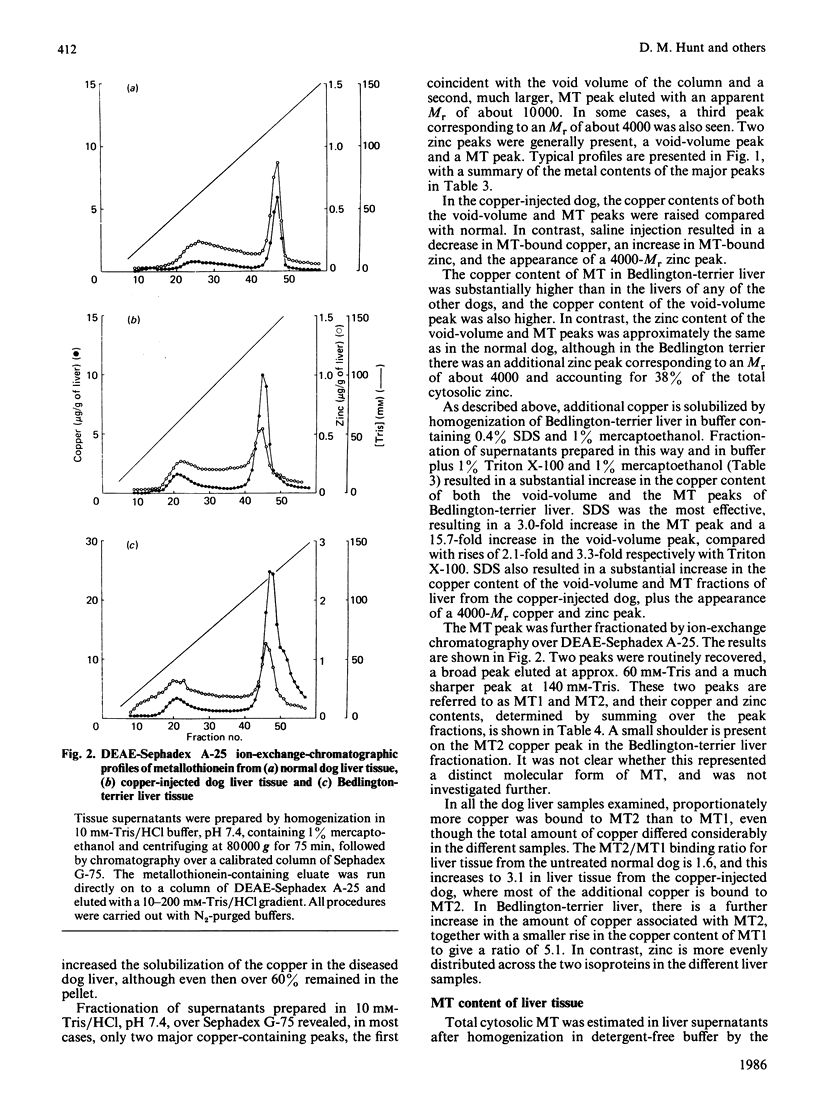
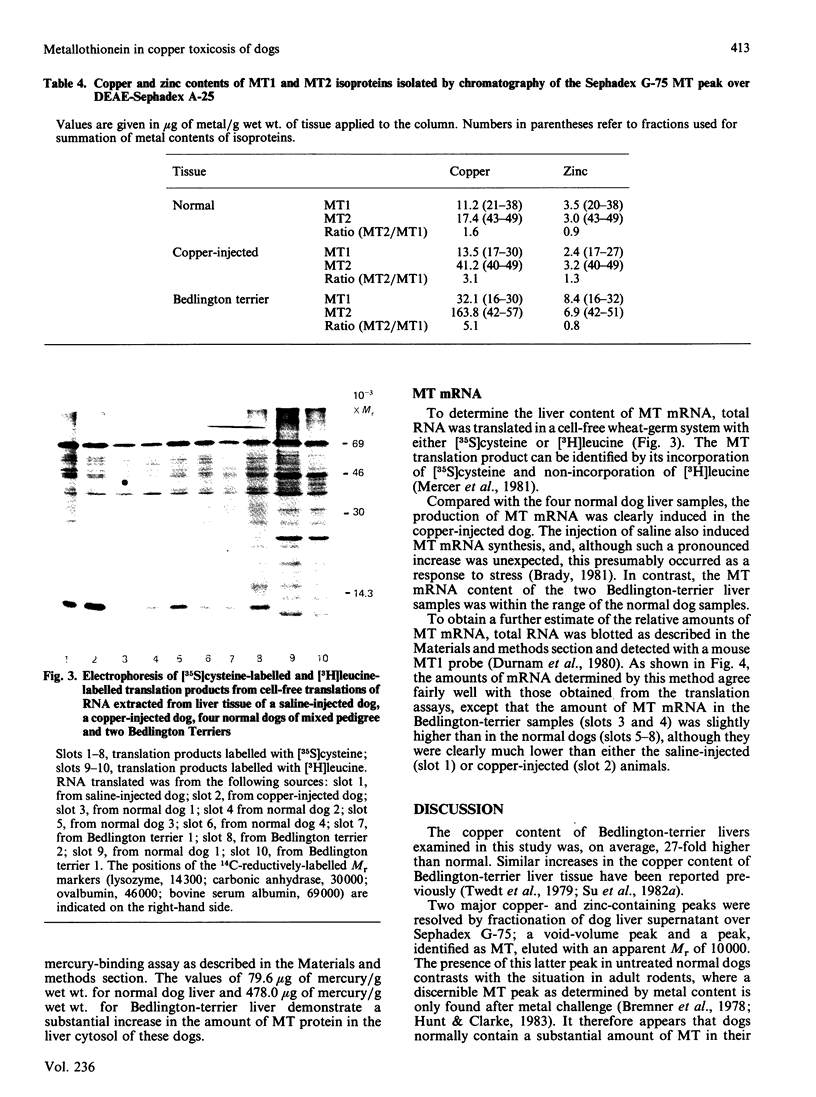
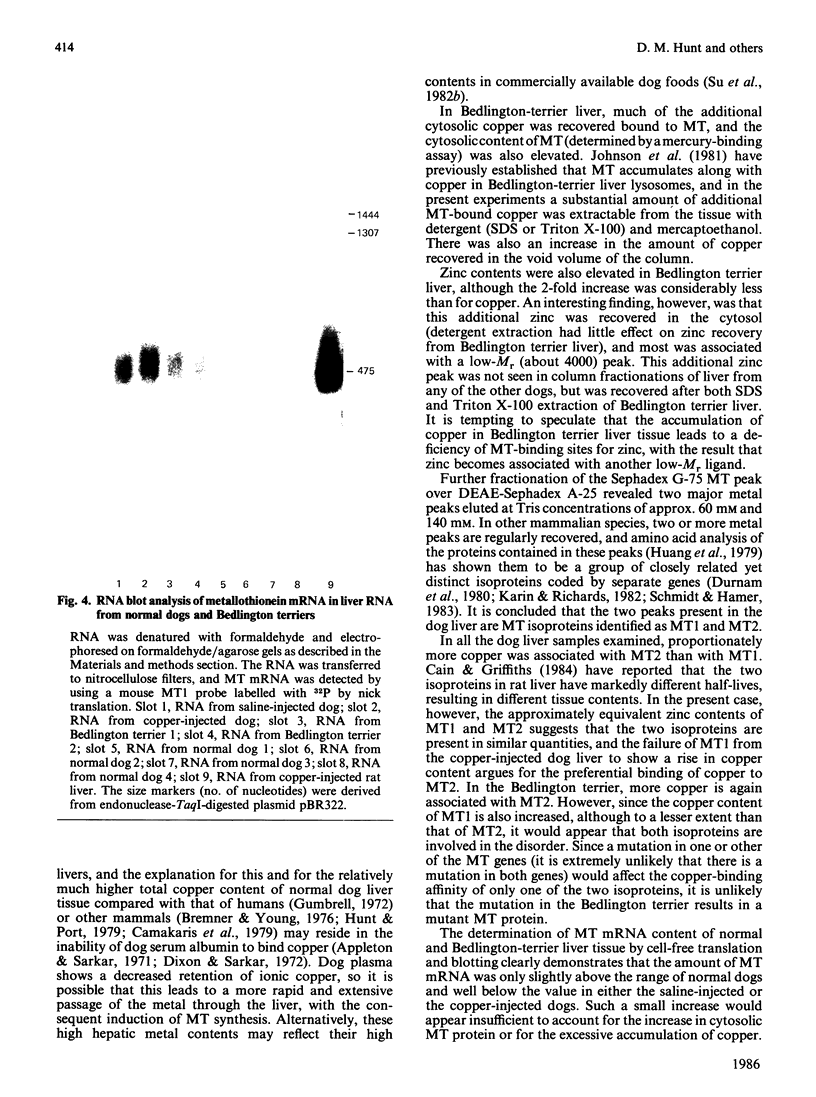
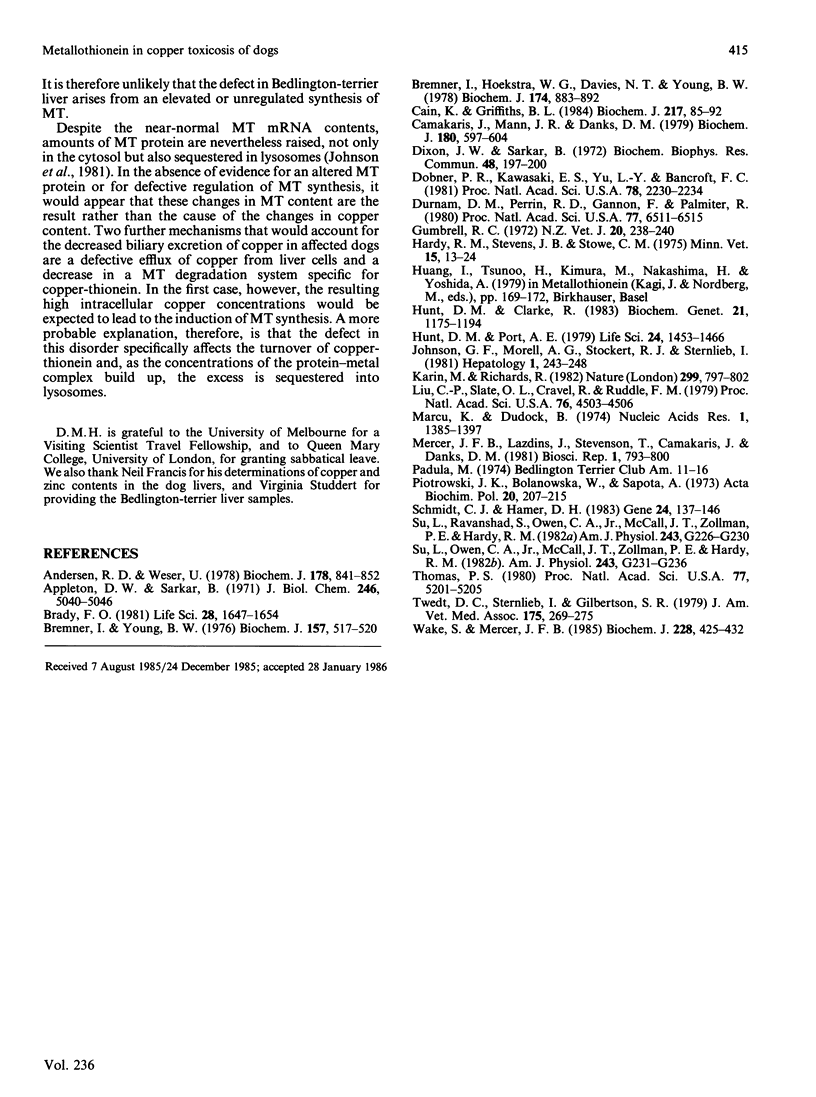
Images in this article
Selected References
These references are in PubMed. This may not be the complete list of references from this article.
- Andersen R. D., Weser U. Partial purification, characterization and translation in vitro of rat liver metallothionein messenger ribonucleic acid. Biochem J. 1978 Dec 1;175(3):841–852. doi: 10.1042/bj1750841. [DOI] [PMC free article] [PubMed] [Google Scholar]
- Appleton D. W., Sarkar B. The absence of specific copper (II)-binding site in dog albumin. A comparative study of human and dog albumins. J Biol Chem. 1971 Aug 25;246(16):5040–5046. [PubMed] [Google Scholar]
- Brady F. O. Synthesis of rat hepatic zinc thionein in response to the stress of sham operation. Life Sci. 1981 Apr 6;28(14):1647–1654. doi: 10.1016/0024-3205(81)90321-0. [DOI] [PubMed] [Google Scholar]
- Bremner I., Hoekstra G., Davies N. T., Young B. W. Effect of zinc status of rats on the synthesis and degradation of copper-induced metallothioneins. Biochem J. 1978 Sep 15;174(3):883–892. doi: 10.1042/bj1740883. [DOI] [PMC free article] [PubMed] [Google Scholar]
- Bremner I., Young B. W. Isolation of (copper, zinc)-thioneins from the livers of copper-injected rats. Biochem J. 1976 Aug 1;157(2):517–520. doi: 10.1042/bj1570517. [DOI] [PMC free article] [PubMed] [Google Scholar]
- Cain K., Griffiths B. L. A comparison of isometallothionein synthesis in rat liver after partial hepatectomy and parenteral zinc injection. Biochem J. 1984 Jan 1;217(1):85–92. doi: 10.1042/bj2170085. [DOI] [PMC free article] [PubMed] [Google Scholar]
- Camakaris J., Mann J. R., Danks D. M. Copper metabolism in mottled mouse mutants: copper concentrations in tissues during development. Biochem J. 1979 Jun 15;180(3):597–604. doi: 10.1042/bj1800597. [DOI] [PMC free article] [PubMed] [Google Scholar]
- Dixon J. W., Sarkar B. Absence of a specific copper(II) binding site in dog albumin is due to amino acid mutation in position 3. Biochem Biophys Res Commun. 1972 Jul 11;48(1):197–200. doi: 10.1016/0006-291x(72)90362-2. [DOI] [PubMed] [Google Scholar]
- Dobner P. R., Kawasaki E. S., Yu L. Y., Bancroft F. C. Thyroid or glucocorticoid hormone induces pre-growth-hormone mRNA and its probable nuclear precursor in rat pituitary cells. Proc Natl Acad Sci U S A. 1981 Apr;78(4):2230–2234. doi: 10.1073/pnas.78.4.2230. [DOI] [PMC free article] [PubMed] [Google Scholar]
- Durnam D. M., Perrin F., Gannon F., Palmiter R. D. Isolation and characterization of the mouse metallothionein-I gene. Proc Natl Acad Sci U S A. 1980 Nov;77(11):6511–6515. doi: 10.1073/pnas.77.11.6511. [DOI] [PMC free article] [PubMed] [Google Scholar]
- Gumbrell R. C. Suspected copper deficiency in a group of full sib Samoyed dogs. N Z Vet J. 1972 Dec;20(12):238–240. doi: 10.1080/00480169.1972.34060. [DOI] [PubMed] [Google Scholar]
- Huang I. Y., Tsunoo H., Kimura M., Nakashima H., Yoshida A. Primary structure of mouse liver metallothionein -I and -II. Experientia Suppl. 1979;34:169–172. doi: 10.1007/978-3-0348-6493-0_8. [DOI] [PubMed] [Google Scholar]
- Hunt D. M., Clarke R. Metallothionein and the development of the mottled disorder in the mouse. Biochem Genet. 1983 Dec;21(11-12):1175–1194. doi: 10.1007/BF00488469. [DOI] [PubMed] [Google Scholar]
- Hunt D. M., Port A. E. Trace element binding in the copper deficient mottled mutants in the mouse. Life Sci. 1979 Apr 16;24(16):1453–1466. doi: 10.1016/0024-3205(79)90028-6. [DOI] [PubMed] [Google Scholar]
- Johnson G. F., Morell A. G., Stockert R. J., Sternlieb I. Hepatic lysosomal copper protein in dogs with an inherited copper toxicosis. Hepatology. 1981 May-Jun;1(3):243–248. doi: 10.1002/hep.1840010309. [DOI] [PubMed] [Google Scholar]
- Karin M., Richards R. I. Human metallothionein genes--primary structure of the metallothionein-II gene and a related processed gene. Nature. 1982 Oct 28;299(5886):797–802. doi: 10.1038/299797a0. [DOI] [PubMed] [Google Scholar]
- Liu C. P., Slate D. L., Gravel R., Ruddle F. H. Biological detection of specific mRNA molecules by microinjection. Proc Natl Acad Sci U S A. 1979 Sep;76(9):4503–4506. doi: 10.1073/pnas.76.9.4503. [DOI] [PMC free article] [PubMed] [Google Scholar]
- Marcu K., Dudock B. Characterization of a highly efficient protein synthesizing system derived from commercial wheat germ. Nucleic Acids Res. 1974 Nov;1(11):1385–1397. doi: 10.1093/nar/1.11.1385. [DOI] [PMC free article] [PubMed] [Google Scholar]
- Mercer J. F., Lazdins I., Stevenson T., Camakaris J., Danks D. M. Copper induction of translatable metallothionein messenger RNA. Biosci Rep. 1981 Oct;1(10):793–800. doi: 10.1007/BF01114802. [DOI] [PubMed] [Google Scholar]
- Piotrowski J. K., Bolanowska W., Sapota A. Evaluation of metallothionein content in animal tissues. Acta Biochim Pol. 1973;20(3):207–215. [PubMed] [Google Scholar]
- Schmidt C. J., Hamer D. H. Cloning and sequence analysis of two monkey metallothionein cDNAs. Gene. 1983 Sep;24(1):137–146. doi: 10.1016/0378-1119(83)90139-7. [DOI] [PubMed] [Google Scholar]
- Su L. C., Ravanshad S., Owen C. A., Jr, McCall J. T., Zollman P. E., Hardy R. M. A comparison of copper-loading disease in Bedlington terriers and Wilson's disease in humans. Am J Physiol. 1982 Sep;243(3):G226–G230. doi: 10.1152/ajpgi.1982.243.3.G226. [DOI] [PubMed] [Google Scholar]
- Thomas P. S. Hybridization of denatured RNA and small DNA fragments transferred to nitrocellulose. Proc Natl Acad Sci U S A. 1980 Sep;77(9):5201–5205. doi: 10.1073/pnas.77.9.5201. [DOI] [PMC free article] [PubMed] [Google Scholar]
- Twedt D. C., Sternlieb I., Gilbertson S. R. Clinical, morphologic, and chemical studies on copper toxicosis of Bedlington Terriers. J Am Vet Med Assoc. 1979 Aug 1;175(3):269–275. [PubMed] [Google Scholar]
- Wake S. A., Mercer J. F. Induction of metallothionein mRNA in rat liver and kidney after copper chloride injection. Biochem J. 1985 Jun 1;228(2):425–432. doi: 10.1042/bj2280425. [DOI] [PMC free article] [PubMed] [Google Scholar]




